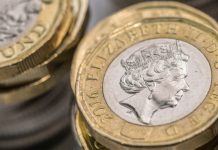The British pound is lower against the Australian dollar on Thursday.
- Pound drop versus Aussie extends to fifth day
- Retail sales in Australia plummet -17.7% in April
- Australian exports and imports slump
- UK awaits next direction on Brexit after talks
GBP/AUD was down by 28 pips (-0.15%) to 1.8894 as of 4pm GMT.
The currency pair was little moved for most of the day, dipped below 1.81 but quickly came off its lows. Yesterday the exchange rate fell -0.18% and it is down -2.05% for the week.
GBP: Waiting for Brexit negotiator comments
For UK-related cues, traders were waiting to hear the conclusion of the latest round of EU/UK trade talks tomorrow. EU Chief Negotiator Michel Barnier and UK Chief Negotiator David Frost have made a habit of listing out the flaws in each other’s negotiating position at the end of the week of talks. Tomorrow may reveal whether rumours earlier in the week of a softening of the UK position had any truth to them.
UK construction activity picked up in May, however it did so by less than expected and remains deeply in contraction at a PMI reading of 28.9 when over 50 denotes expansion.
AUD: Retails sales, exports and imports slump
The optimism across global markets dimmed slightly on Thursday, limiting the upward progress in the Australian dollar. Added to that, Australian retail sales registered a sharp drop of -17.7% in April, although that was slightly better than the -17.9% decline anticipated. Likewise imports and exports both fell in the region of -10% over the month.
Australian shares have gained every day this week with markets pricing in a V-shaped economic recovery after high-frequency data points from across the globe like jobless claims and PMIs have improved in May from the record declines in April during the peak of government-enforced lockdown.
The Australian dollar has continued to rise this week, even as data showed the economy declined by -0.3% in the first three months of the year. Treasurer Josh Frydenburg warned the economy will lose value again in Q2, leading to Australia’s first recession in three decades.





